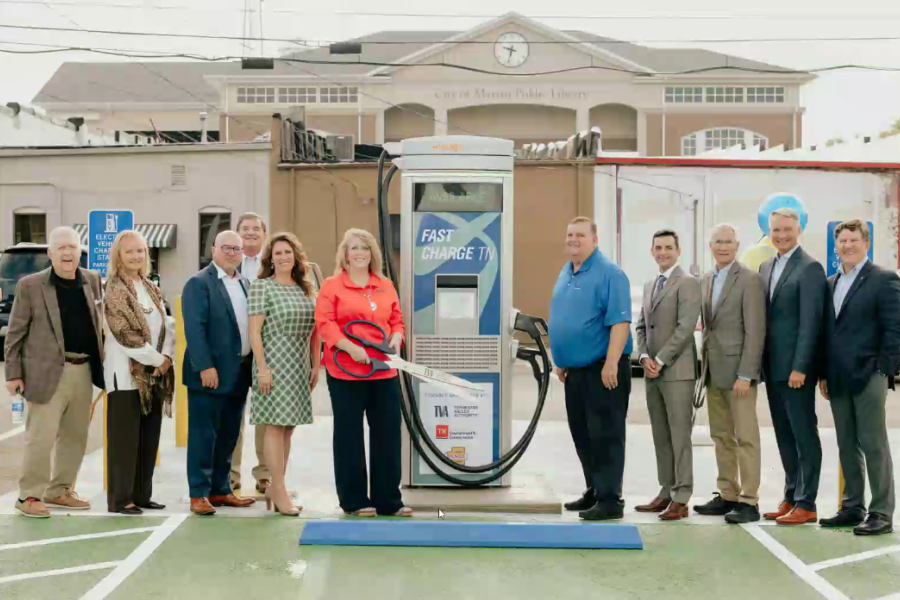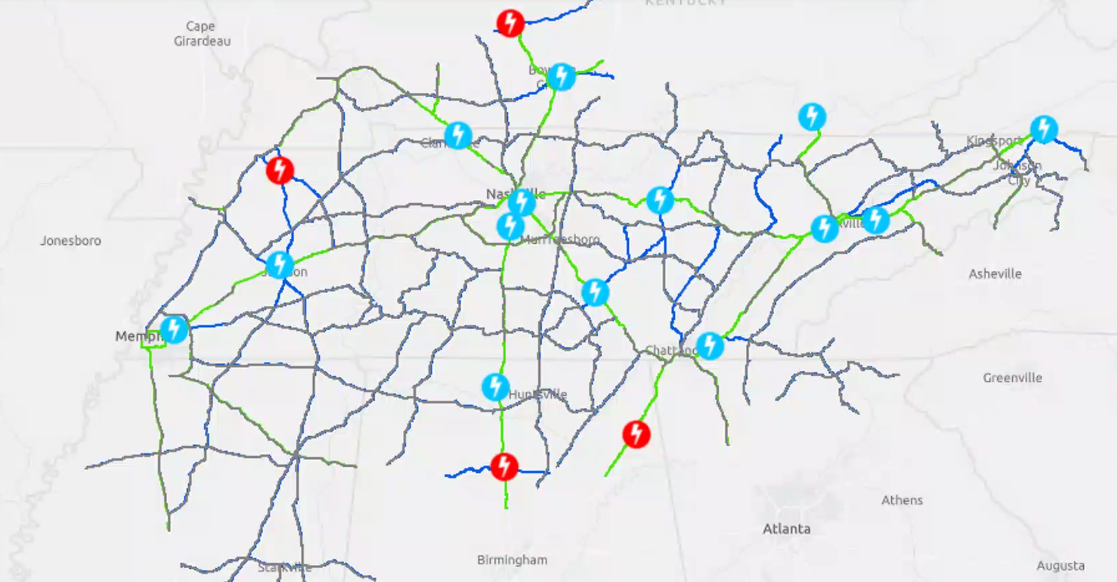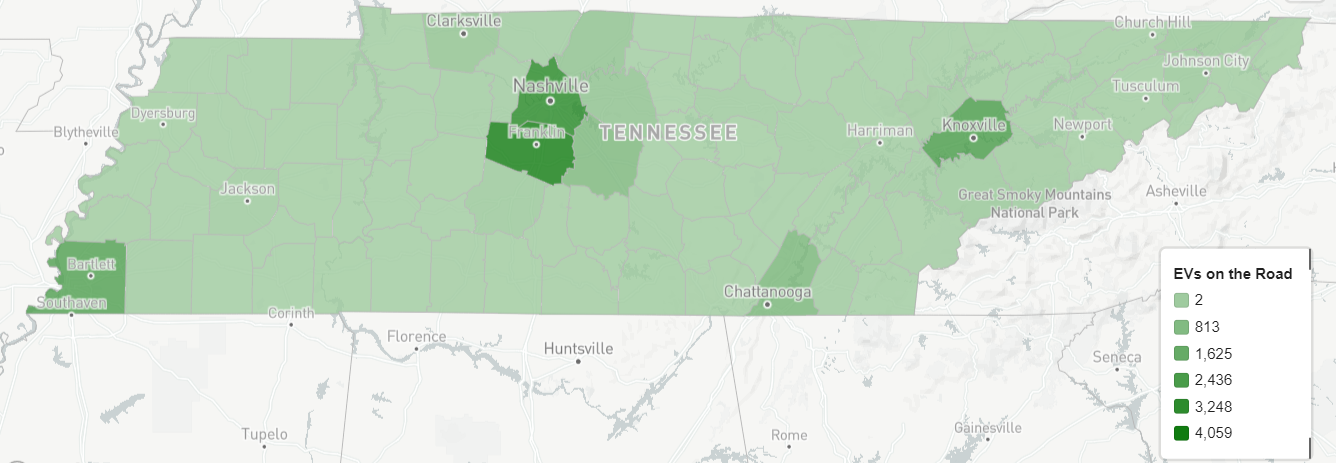Opportunities on the horizon for cities interested in becoming part of EV charging network

By KATE COIL
TML Communications Specialist
State officials delivered an update on Tennessee’s electric vehicle infrastructure as well as how municipalities can participate in the building of this network through state and federal programs aimed at developing fast charging stations during the most recent Blue Oval City Community Impact meeting.
In 2018, Drive Electric TN and the Tennessee Valley Authority (TVA) kickstarted a program that would bring the total number of EVs owned by Tennessee residents to 200,000. With a growing market for EVs and more EVs being made in the state, plans are progressing to build both Tennessee’s portion of the federal Fast Charge network as well as plan for more localized EV infrastructure needs.
The purpose of the federal and state fast-charge networks is to ensure that EVs can navigate along the major interstate and highway corridors across the country and state without experiencing range anxiety, or the concern that there will not be enough charging stations in place to complete a trip.

Alexa Voytek, deputy director of programs with TDEC’s Office of Energy, described the fast-charge network as a “minimum, viable backbone” to connect motorists and communities. TDEC and TVA identified major corridors across the state, leveraging VW settlement funds and TVA funding to create the Fast Charge TN Network, and are presenting working to bring fast charges to these locations.
“We have a corridor completeness map we use as we develop these stations,” Voytek said. “There is just one in Tennessee today located in Martin, which is the first fast-charge location in Tennessee to go online. There are other existing Electrify America DC fast charging stations that meet our criteria. We have just executed all of our contracts for TDEC funded projects, which will soon be underway. We will slowly start to fill in this map.”
Andrew Frye, power utilities engineer with TVA, said the Fast Charge TN program is aimed at local power companies who are customers of TVA to install, own, and operate fast chargers along major corridors at least every 50 miles.
“To do that, we are cooperating with the municipalities and power cooperatives under TVA,” Frye said. “The program reimburses the costs of local power companies up to 80% to install a couple of fast chargers that meet all of the program specifications. Between TVA and TDEC, we have about 50 different sites in the pipeline being worked on. It’s a broad-reaching program to get every 50 miles covered. We think it will take an additional 80 locations. There are only 30 publicly available, DC fast-charging sites available now, and we will be adding another 80 of those. Each site will have at least two charging stations but some will have up to four.”
Matt Meservy, director of TDOT’s Long Range Planning Division, said the agency is also working on the infrastructure of the Tennessee Electric Vehicle Infrastructure (TEVI) plan, which provides a different funding source for similar infrastructure installation.
TDOT will have $88.33 million over the next five years to build both fast-charging and then secondary network charges. Initially, charging stations must be along the state’s six major interstates – 24, 26, 40, 65, 75, and 81 – as well as U.S. Highway 64 and are similar fast-chargers to those being used by the Fast Charge TN project.
“The TEVI program requires us to fill the gaps that are identified on our alternative fuel corridors,” Meservy said. “Our priority – and the only way that we can use the additional funding through the TEVI plan – is to fill these gaps first. That is our priority at this moment. Our biggest hurdle will be to cover U.S. 64 because at the moment there aren’t any stations located there. We cannot move forward with additional funding and the phase two approach until we have satisfied all these gap requirements.”
While building out the fast-charge remains the primary focus, planning is already being done toward bringing EV charging capacity to secondary markets. Leftover federal funds from the TEVI program could be used to do this once the initial fast-charge network is done.
“As part of a phase two approach, there has been discussion about using these funds for workforce development to make sure we can train some of our Tennessee residents to be actively part of the EV infrastructure and its adoption,” Meservy said.
Municipalities may consider different types of charging stations depending on how long and for what purpose they want visitors to come to their community. While some communities may be a good fit for the fast-charge network, others might prefer slower chargers that encourage users to spend more time in the community.
“Fit the application to the charging station,” Frye said. “If you want people to be in an area longer, like in a park or a downtown area, maybe look at a level two station rather than a fast-charging one. If you want people to briefly get off the interstate to visit a gas station or restaurant, then you are looking at the fast chargers.”
There are three levels of charges with the first being 110 volt-chargers that are already the standard outlet for most homes with no modifications needed to charge electric vehicles. While plugging a vehicle into a standard house outlet may not completely charge a vehicle overnight, Frye said those who travel less than 50 miles in a day might find they can use this basic form of charging with no issues.

The level two or 240 volt chargers take several hours to charge and can be installed in homes or businesses with slight modifications. While home appliances like dryers and stoves often use outlets of this nature, many choose to have an electric install a specific 240-volt outlet into their garage for charging purposes. Many chargers or outlets for this nature are also available at hotels, shopping malls, or businesses. These chargers can cost anything from a couple thousand dollars for a home install to around $10,000 for a business or public location.
Level three or fast chargers that can charge a vehicle fully in between 30 minutes to a few hours. The most expensive type of charger, these facilities are most often installed at major interstate interchanges where users can get a meal or briefly rest while charging their vehicle for a long trip.
There are also incentives from both the public and private sector available to help manage install costs. Voytek said the federal government plans to soon make $2.5 billion available in two separate grant programs aimed at building vehicle charging infrastructure.
“One is community charging focused, and so local governments could apply directly for that to install community charging,” she said. “The other program is still corridor focused, but also includes other alternative fuels like natural gas and propane. We expect to see that program very soon. Under the Volkswagen settlement, we also set aside a tiny amount of funding that can go toward EV charging infrastructure outside of the Fast Charging network. We have contemplated two secondary network programs that we will probably be released in 2023. One of those will be focused on multi-family housing and the other will be focused on rural destination charging.”
Voytek said local officials may want to talk to their local energy company to see if they would consider offering rebates or incentives to encourage the installation of charging infrastructure both commercially and developers as well as the adoption of EVs.
There are certain tax credits available for commercial and residential charging stations and some auto manufacturers or dealerships offer rebates for installing charging stations, especially through charging companies they partner with. GM has even launched a program encouraging local GM dealerships to install 10 charging stations at locations throughout their own communities to encourage EV purchases.
Voytek said as more municipalities begin electrifying their fleets it may also encourage the addition of charging stations at municipal properties or within the community.
“We work a lot with local governments throughout the state who are starting to evaluate these options and look at the different vehicle types that are out there,” she said. “That could be light duty vehicles or even all-electric vans or delivery options. There is a lot out there for governments to start evaluating for their own needs as well.”
To better educate themselves and their communities about electric vehicles and upcoming EV-related opportunities, Voytek said leaders should reach out to Drive Electric TN and see if they have a local chapter of the group or want to start one in their community.

